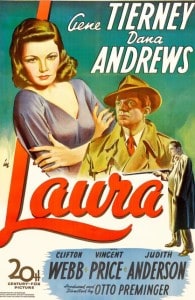 “I write with a goose quill dipped in venom.”——Waldo Lydecker
“I write with a goose quill dipped in venom.”——Waldo Lydecker
If from Laura you remember the best of Clifton Webb’s acerbic lines and David Raksin’s lush music—and, oh, yes, the long scene where Dana Andrews walks around the “dead” woman’s apartment and stares at her portrait over the fireplace—then you’ve remembered the best parts of the 1944 film that became, almost from the day of its release, the exemplar of the greatest genre of that decade, the film noir.
Just the opening narration—especially that first line—is one of the great introductions in Hollywood history: “I shall never forget the weekend Laura died. A silver sun burned through the sky like a huge magnifying glass. It was the hottest Sunday in my recollection. I felt as if I were the only human being left in New York. For with Laura’s horrible death, I was alone. I, Waldo Lydecker, was the only one who really knew her, and I had just begun to write Laura’s story when another of those detectives came to see me. I had him wait. I could watch him through the half-open door.”
As the camera pans the plush living room and the waiting detective Mark McPherson (Andrews) wanders among the collection of crystal and china, Lydecker (Webb) continues the narration: “I noted that his attention was fixed upon my clock. There was only one other in existence, and that was in Laura’s apartment, in the very room where she was murdered.” The work of a shotgun blast to the woman’s face made her totally unrecognizable, a key element in this murder mystery, and a basis for much misunderstanding and erroneous assumptions.
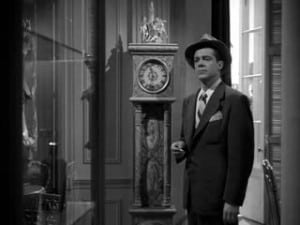 And don’t forget the floor clock, which chimes while McPherson is waiting. Yes, don’t forget the clock! McPherson will forget it, up until the very last.
And don’t forget the floor clock, which chimes while McPherson is waiting. Yes, don’t forget the clock! McPherson will forget it, up until the very last.
[intlink id=”127″ type=”category”]Gene Tierney[/intlink], now as Laura, “dead” in the first forty-five minutes of the movie, starred in her most famous role despite earlier critical success in Heaven Can Wait and a later Oscar nomination for Leave Her to Heaven. Some say she rendered an even better performance in The Razor’s Edge, but Anne Baxter stole the show as the suffering alcoholic—and won a Supporting Actress Oscar.
In Laura, Clifton Webb as the erudite radio personality and totally self-involved newspaper critic—the subject of himself, he boasts, is “completely justified”—is a less versatile performer, a former Broadway dancer and silent screen obscurity. The uppity character of Lydecker, which many an astute viewer will assume, possibly correctly, to be Webb’s own, would be replicated, even down to his suit and hat, in his next film, The Dark Corner. Same for the part of Elliott Templeton as Tierney’s co-star in The Razor’s Edge. And so his portrayals would continue as variations on Lydecker—in Titanic (1953) and Three Coins in the Fountain (as another writer), and, for that matter, for his best-remembered role as Lynn Belvedere in a series of three films centered around that eccentric character.
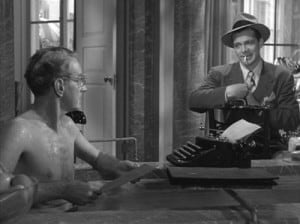 Although occupying as much screen time as Andrews or Tierney, Webb was Oscar-nominated for his supporting performance, losing to the cuddly sentimentality of Barry Fitzgerald in Going My Way. This was, after all, during World War II, and although an Allied victory was assured by the time the ballots were counted, the nation was war-exhausted and still needed that warm optimism. Andrews, and rightly so, was not nominated for Best Actor, the award going to—oops, here we go again!—Bing Crosby, Fitzgerald’s fellow, almost-as-cuddly priest in Going My Way.
Although occupying as much screen time as Andrews or Tierney, Webb was Oscar-nominated for his supporting performance, losing to the cuddly sentimentality of Barry Fitzgerald in Going My Way. This was, after all, during World War II, and although an Allied victory was assured by the time the ballots were counted, the nation was war-exhausted and still needed that warm optimism. Andrews, and rightly so, was not nominated for Best Actor, the award going to—oops, here we go again!—Bing Crosby, Fitzgerald’s fellow, almost-as-cuddly priest in Going My Way.
[intlink id=”172″ type=”category”]Dana Andrews[/intlink], the hard, stone-faced detective in Laura, would never again appear in films of the success and quality of “his” decade, the 1940s. Besides Laura, the highlights of those years for him include The Ox-Bow Incident, The Purple Heart, A Walk in the Sun, The Best Years of Our Lives and My Foolish Heart. Later, in 1957, he would appear—still stone-faced as was his inflexible demeanor—in a genre atypical of him, the intelligent horror film Night of the Demon.
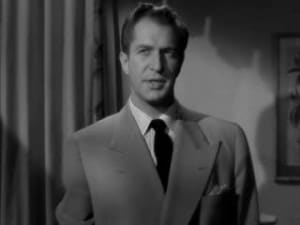 The remaining two stars who received screen credit are a young Vincent Price as an unemployed lounge lizard, the actor yet to assume his familiar place as a master of the horrors, and Judith Anderson as Laura’s aunt and Price’s on-and-off-again girlfriend. Anderson never bettered her role as Mrs. Danvers in Rebecca in 1940 despite a half-century of sporadic film appearances and similar ventures as austere women in Kings Row, The Red House and Cat on a Hot Tin Roof. Maybe the general downturn of her career was partially due to her own somewhat severe facial features.
The remaining two stars who received screen credit are a young Vincent Price as an unemployed lounge lizard, the actor yet to assume his familiar place as a master of the horrors, and Judith Anderson as Laura’s aunt and Price’s on-and-off-again girlfriend. Anderson never bettered her role as Mrs. Danvers in Rebecca in 1940 despite a half-century of sporadic film appearances and similar ventures as austere women in Kings Row, The Red House and Cat on a Hot Tin Roof. Maybe the general downturn of her career was partially due to her own somewhat severe facial features.
Some of the uncredited supporting players whose names might be familiar are Dorothy Adams (as Laura’s maid, a large enough role that deserved screen credit), Lee Tung Foo, Cara Williams, Clyde Fillmore, Jean Fenwick, William Forrest and silent screen star Aileen Pringle. Their mostly unsung careers, though long and prolific, did not, at least, suffer the insult of Grant Mitchell (the invaded homeowner in The Man Who Came to Dinner), whose scenes in Laura as Lancaster Corey were eventually cut.
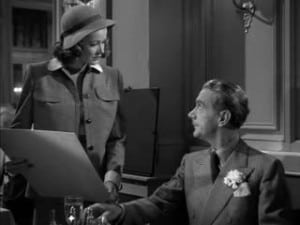 Much of the first forty-five minutes of Laura is told in flashback by Lydecker, mainly to McPherson, beginning when Laura Hunt, a beautiful advertising executive, interrupts the famous critic’s lunch at the Algonquin Hotel and asks him to endorse one of her products. “My dear,” he intones, “either you were born on an extremely rustic community, where good manners are unknown, or you suffer from a common feminine delusion that the mere fact of being a woman exempts you from the rules of civilized conduct.” This is as good an example as any of Lydecker’s caustic, florid dialogue.
Much of the first forty-five minutes of Laura is told in flashback by Lydecker, mainly to McPherson, beginning when Laura Hunt, a beautiful advertising executive, interrupts the famous critic’s lunch at the Algonquin Hotel and asks him to endorse one of her products. “My dear,” he intones, “either you were born on an extremely rustic community, where good manners are unknown, or you suffer from a common feminine delusion that the mere fact of being a woman exempts you from the rules of civilized conduct.” This is as good an example as any of Lydecker’s caustic, florid dialogue.
He obviously refuses to endorse her product, a pen. The next day, however, he arrives at her office. He’s changed his mind—and invites her to dinner. They begin seeing one another, she receiving the benefits of his supposed culture and sophistication; he chooses her hairdresser, selects her wardrobe and introduces her to the famous and the infamous. As he tells McPherson, “Tuesday and Friday nights we stayed home,” and she would cook dinner for him.
 Through his newspaper column and various deceptions, Lydecker is able to discredit Laura’s suitors—first the man, Jacoby, who painted her portrait which hangs in her apartment, then Shelby Carpenter (Price) when the two become engaged and even McPherson when Lydecker suspects the detective is falling in love with the murder victim. He warns him he might end up in a mad house: “I doubt they’ve ever had a patient who fell in love with a corpse.”
Through his newspaper column and various deceptions, Lydecker is able to discredit Laura’s suitors—first the man, Jacoby, who painted her portrait which hangs in her apartment, then Shelby Carpenter (Price) when the two become engaged and even McPherson when Lydecker suspects the detective is falling in love with the murder victim. He warns him he might end up in a mad house: “I doubt they’ve ever had a patient who fell in love with a corpse.”
In the crux, and in many ways the highlight, of the film, McPherson spends an evening wandering about Laura’s empty apartment, carrying a packet of her letters, opening her lingerie drawer, looking in her clothes closet and returning, again and again, to stand in front of her portrait. He has already read her diary. He sits in an upholstered chair, bottle and drink in hand. As if unable to resist, his eyes once again turn slowly to the painting, then he falls asleep. Gradually he is awakened by someone who enters and turns on a light. Laura. Dressed in raincoat and rain hat, she has come in out of the downpour and wants to know who he is, and what he is doing in her apartment.
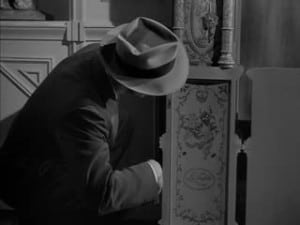 Much later, McPherson finds a secret compartment—empty—in that white floor clock in Lydecker’s apartment and remembering that other identical clock, he goes to Laura’s apartment. There he finds Laura and Lydecker, who had earlier fainted when he first saw his resurrected love. When Lydecker insults the detective, she sends him away.
Much later, McPherson finds a secret compartment—empty—in that white floor clock in Lydecker’s apartment and remembering that other identical clock, he goes to Laura’s apartment. There he finds Laura and Lydecker, who had earlier fainted when he first saw his resurrected love. When Lydecker insults the detective, she sends him away.
Now McPherson opens the secret compartment in her clock and finds the shotgun Lydecker used to kill a model he mistook, in the dark, for Laura; the model, Diane Redfern, was staying in Laura’s apartment, even wearing her nightgown, while Laura was away in the country. Unwisely, but a script requisite, McPherson returns the shotgun to its hiding place; surely, any respectable policeman would have confiscated it as evidence and for ballistic analysis—and, while at it, why did no one miss the model?
McPherson tells Laura to remain locked in her room and to open the door to no one. After he has departed, Lydecker, who had not left the building, emerges from hiding. As Laura prepares for bed, she switches on the radio to Lydecker’s evening broadcast, his subject, as he told her when departing moments earlier, is the great lovers of history. The broadcast is what was then called an electrical transcription. (This recalls another similar broadcast and another radio host, Claude Rains, with his own plans for murder in The Unsuspected of 1947, though hardly in a class with Laura.) Lydecker enters the apartment with his own key, opens the clock and loads the shotgun with two shells from his pocket. He proposes to kill her, saying if he can’t have her, no one can.
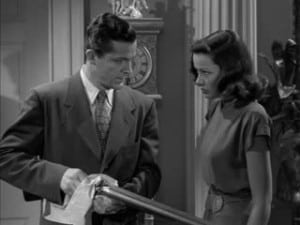 Meanwhile, as McPherson was leaving the building, the sergeant at the entrance says he never saw Lydecker leave. They race to Laura’s apartment. The sergeant shoots Lydecker before he can harm Laura and the critic utters his dying words, now unusually succinct: “Goodbye, Laura. Goodbye, my love.” (It’s a little implausible that the two detectives took so long to intervene, given all the time Laura wandered about her bedroom, listened to the radio and Lydecker gave his speech.)
Meanwhile, as McPherson was leaving the building, the sergeant at the entrance says he never saw Lydecker leave. They race to Laura’s apartment. The sergeant shoots Lydecker before he can harm Laura and the critic utters his dying words, now unusually succinct: “Goodbye, Laura. Goodbye, my love.” (It’s a little implausible that the two detectives took so long to intervene, given all the time Laura wandered about her bedroom, listened to the radio and Lydecker gave his speech.)
The making of Laura has a torturous history typical of many a Hollywood enterprise. That the film, against all the odds, turned out a classic is a tribute to the artists who worked on it and to the insistence by a few that its integrity be respected. Sure, the plot is somewhat implausible and Lydecker’s dialogue, however urbane and florid, is unrealistic.
The problems began from the first, with the adaptation of Vera Caspary’s seemingly inadaptable play, then novel, which had shifting viewpoints from each of the main characters. This was reduced to only Lydecker’s perspective. The plot and dialogue were reworked by several writers, including the final director.
The original director, Rouben Mamoulian, was replaced after filming had begun by the autocratic Otto Preminger, who claimed he reshot all of Mamoulian’s footage. That has since been disputed. Preminger replaced cameraman Lucien Ballard with Joseph LaShelle, who apparently was good enough to win the film’s only Oscar, for B&W cinematography.
And the stars! The initial choices were Laird Cregar as Lydecker and John Hodiak as the detective. In 1944, Cregar had starred in The Lodger and Hodiak in Alfred Hitchcock’s Lifeboat, so both their stars were in ascendance. Unfortunately, both died tragically young, Cregar at the end of that year, age 31, an operation gone wrong, and Hodiak ten years later at 51, from a heart attack.
Jennifer Jones was first suggested for the title role but turned it down, and Tierney, who didn’t want the part, submitted only because of contractual obligations.
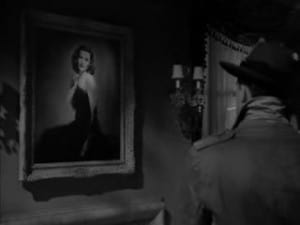 Even the portrait of Laura that hangs over the fireplace has a checkered history. The original painting by Mamoulian’s wife was replaced by the all-controlling Preminger with an enlarged photograph of Tierney, which was layered with oil paints and brush strokes to give the impression of a painting. The portrait would reappear in several subsequent films.
Even the portrait of Laura that hangs over the fireplace has a checkered history. The original painting by Mamoulian’s wife was replaced by the all-controlling Preminger with an enlarged photograph of Tierney, which was layered with oil paints and brush strokes to give the impression of a painting. The portrait would reappear in several subsequent films.
The most famous problem with Laura concerned the score. Alfred Newman, 20th Century-Fox’s music department head, was initially assigned, but he had a full workload and suggested Bernard Herrmann. Herrmann, who would later compose some of his best scores for that studio, declined, some say because he didn’t want work Newman had turned down, whatever the reason.
The final choice, and as it proved the composer who made the title melody famous, was the then little-known David Raksin, up until Laura a house orchestrator and composer who mostly worked without screen credit. Problems and obstacles persisted. To represent the heroine, Preminger, who had called the character of Laura a whore during production sessions, thought George Gershwin’s “Summertime” or Duke Ellington’s “Sophisticated Lady” would be appropriate.
Raksin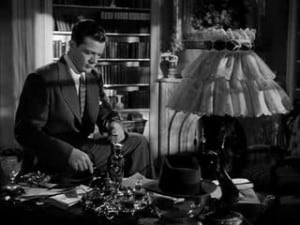 warned that these songs, long well known, carried their own baggage of associations, and that the film needed something original and uniquely its own. In response, Preminger declared, “All right—today is Friday. If you can come in with something we like by Monday, okay—otherwise we use ‘Sophisticated Lady.’ ” Raksin did not regard Laura as a whore. “[I was] already enchanted by Gene Tierney’s marvelous face,” he wrote in his liner notes for an offshoot of RCA’s “Classic Film Score” series of the 1970s, an album devoted to three Raksin scores: Laura, Forever Amber and The Bad and the Beautiful.
warned that these songs, long well known, carried their own baggage of associations, and that the film needed something original and uniquely its own. In response, Preminger declared, “All right—today is Friday. If you can come in with something we like by Monday, okay—otherwise we use ‘Sophisticated Lady.’ ” Raksin did not regard Laura as a whore. “[I was] already enchanted by Gene Tierney’s marvelous face,” he wrote in his liner notes for an offshoot of RCA’s “Classic Film Score” series of the 1970s, an album devoted to three Raksin scores: Laura, Forever Amber and The Bad and the Beautiful.
In these notes, Raksin relates going home and sitting at the piano, waiting for inspiration. He had received, that Saturday, a letter from his wife, wanting to end their marriage. “I took the letter out of my pocket, put it upon the piano and began to play. . . . I felt the last of my strength go, and then—without willing it—I was playing the first phrase of what you now know as ‘Laura.’ I remember being in no particular hurry to write it down for fear of losing it, but I knew it was the real thing and stumbled through it again and again in a sweat of catharsis and self-indulgence.”
Talk about being erudite, and with a musician’s technical prowess, Raksin discusses the three scores he conducts with the New Philharmonia Orchestra. If for no other reason, though the music itself is varied and sophisticated beyond most movie soundtracks, the album is recommended just for his fifteen pages—if the 1976 original and 1989 reissue are still available intact. David Raksin died in 2004.
The melody representing Laura, put to lyrics by Johnny Mercer, became famous as early as 1945 with a recording by Woody Herman and His Orchestra, with Woody as vocalist. The song has since been recorded by countless artists as diverse as Stan Kenton, Dick Haymes, Charlie Parker, Nat King Cole and Frank Sinatra.
As if all these obstacles were not enough, studio head Darryl F. Zanuck wanted to cut the pivotal scene where McPherson walks around Laura’s apartment and repeatedly stares at the portrait. Raksin, once again in the film’s defense, successfully argued that without that six-minute scene, already shortened from its original length, the audience would fail to realize that McPherson had fallen in love with Laura.
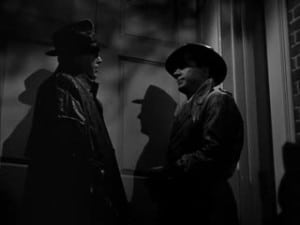 The scoring cue for the most famous scene in Laura begins with fragmented trumpets, though suggestive of the theme to come, as McPherson, on foot, approaches Laura’s apartment building in the rain. He tells the sergeant at the entrance to take a long lunch break. McPherson obviously wants some time to himself—and does he want, as well, to “be with” Laura?
The scoring cue for the most famous scene in Laura begins with fragmented trumpets, though suggestive of the theme to come, as McPherson, on foot, approaches Laura’s apartment building in the rain. He tells the sergeant at the entrance to take a long lunch break. McPherson obviously wants some time to himself—and does he want, as well, to “be with” Laura?
As he opens the door to Laura’s empty apartment, out of a hovering haze in the orchestra comes—yes!—the melody that has permeated this monothematic score all the while. As source music, the melody has been heard at least twice on the radio and once from a restaurant trio of piano, violin and accordion. The “Laura” tune becomes richer, yet somehow sadder as McPherson approaches and stands before the portrait.
The tune soon becomes vague and disappears, replaced by the murky loneliness of a solo bassoon, then by menacing brass, off in the distance, as if in another room, maybe the room McPherson strolls into next. The desolate bassoon returns and strings struggle to find the tune again, still not fully given. Later, as the detective wanders through another room, a muted trumpet is answered by woodwinds. Then, like a faint ray of light, a piano, accompanied by a celesta, gives out “Laura” in its most skeletal form.
When Lydecker arrives to give his “in love with a corpse” line and then is ordered out by McPherson, there is no underpinning score; the music—and Laura—belongs solely to McPherson. And only after Lydecker has left does “Laura” return, with a new, brighter variation, now in light string counterpoint, segueing into a high solo violin. Muted trumpets return as the detective sits in the armchair. As he falls asleep, strings briefly, softly hint at the tune, and the music has evaporated by the time Laura, in the flesh, has entered and turned on a light.
I like your post and I love this film. But I think you underestimate Dana Andrews’s acting talent. Part of the reason, I think, the film is timeless is due to his and Gene Tierney’s understated performances that are free from exaggerated acting affectations. I think both Andrews and Tierney deserved Oscar nominations for their performances. In spite of the above, this is a wonderful post.
Wonderful post. Can’t believe I haven’t yet seen this film!!! Doh!
Touching story about composer Raskin receiving the letter from his wife and then beginning to play the piano…
LAURA has long been one of my favorite films, and I very much enjoyed your review! I’m also a big fan of Laird Cregar, who’d hoped to be cast as Waldo Lydecker. Alas, he was shut out because the producers supposedly thought that since our man Laird had already played many heavies (literally and figuratilvely), Fox thought audiences would realize his character’s true colors and give away the surprises. Poor Laird, but a great post!
A really enjoyable and informative review of this classic.
This just might be one of those films that has love universally. And rightly so. Loved Price in it too. So glad it’s October so we get to see a lot more of him.
Page
You’re right that the shotgun would have been confiscated, but you can’t do a ballistic check on shot.
I beg to differ with one of your statements about the female stars that were chosen for the lead. You were right that Jennifer Jones was the first choice, but then Otto Preminger wanted Hedy LaMarr, who was under contract to MGM and they refused to loan her out, as well as for the lead in “Casablanca”. In a Tierney interview she so stated, and she did say, she didn’t think she was that type of a woman that a detective would just fall in love with a portrait, but being under contract with 20th Fox, she accepted it. Hedy once said, if she had heard the theme “Laura”, she would have accepted it, but that was just a flattery praise for the theme…MGM still refused to loan her.
Seems odd that “prissy” Webb would have a thing for Earth Goddess Tierney! However suspension of disbelief works every time.